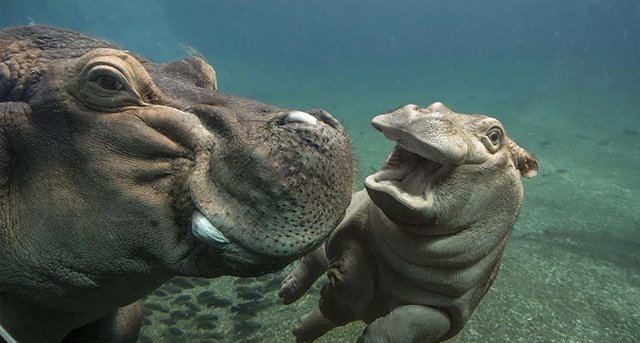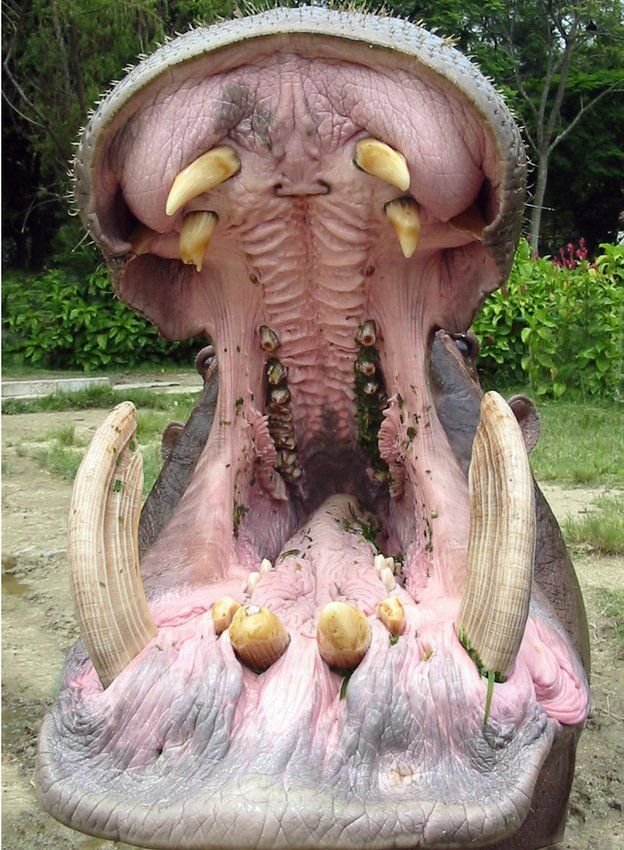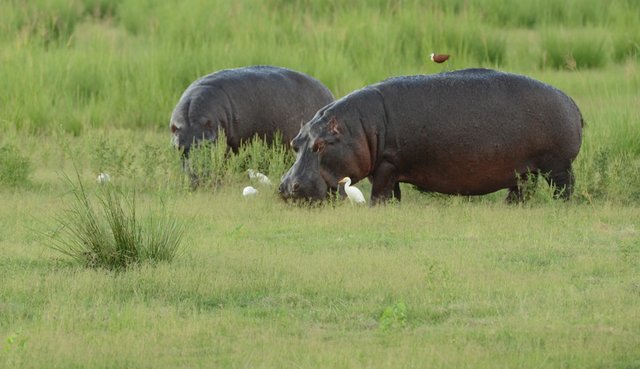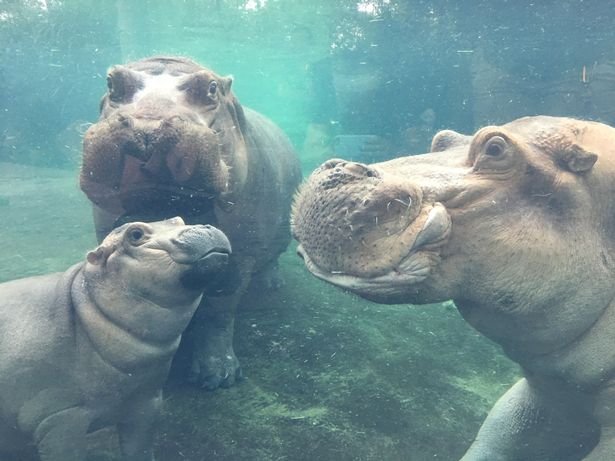Amazing Animals #9 The Hippopotamus
I find the Hippo to be one of the most intriguing animals on this planet, their immense size and amphibious lifestyle is a truly unique sight in the Animal Kingdom and they are a more than worthwhile animal to cover in this series.
Hippo Anatomy and Life
The Hippopotamus (Hippopotamus amphibius) ranks as the third largest land-dwelling animal, the average Hippo measures 3.5 metres in length, stands 1.5 metres tall and weighs between 1500-3300 Kg's with their offspring already weighing roughly 25-50 Kg's at birth.
When observing Hippos, it is relatively difficult to determine their sex as there isn’t a huge size difference between males and females, older males are only more distinguishable than females as they will have larger Muzzles and teeth, unlike most Mammals their testicles are not visible, but are instead located in a canal within the Abdomen.
The Mouth
Diet
When viewing a Hippo and their impressive teeth you might think that they are adapted to eat meat, though their diet is almost entirely herbivorous.
Although they are Herbivores they are also opportunists, in times of drought and seasonal famine some groups of Hippo have been observed to eat meat to survive, their guts are however not optimised to breakdown meat and too much of it can result in sickness, though, eating nothing during famine will likely result in death, so it’s certainly worth the risk of sickness.
Social behaviour
Hippos are sociable animals that live in groups of up to 30 animals known as bloats, they are Hierarchical animals and the bloat will consist of a single dominant male, all other members of the bloat will either be female or calves. The male may also allow younger males to be part of the bloat so long as they remain submissive and do not make any attempt to mate with the females.
The bloat is formed when a male Hippo stakes a claim to a stretch of territory most commonly a section of river, female Hippos are drawn to dominant males and the size of the bloat will be dictated by the male’s ability to fend off challengers as well as the surrounding grazing habitat.
The large canine teeth mentioned in the article continue to grow throughout the Hippos life meaning older males will have an advantage in combat, hippo confrontations can last for hours and can result in the death of one or both participants if the injuries they sustained in battle are severe enough. Within the herd the male will often segregate himself from the females, calves naturally stay close to their mothers, though as they age the females will stay with their mothers and the young males will likely segregate to their own area, forming a small bachelor group.Despite forming a seemingly close herd they are incredibly territorial animals and live individualist lifestyles within the herd, if a female is with a calf she will prioritise the calves needs over any other member of the herd and may even resort to conflict if she feels her calves safety is in jeopardy.
Hippos communicate through a wide range of vocalisations which are still not entirely understood by researchers, most vocalisations consist of deep grunts and low bellows and it is thought that Hippos may be capable of echolocation like Dolphins, though more research is required to verify this claim. They do however have on of the most unique forms of communication in the Animal Kingdom, by raising their head partly above the water’s surface they can send sound waves through both the air and land, this means they can communicate to other Hippos that may not necessarily be nearby.
One of the Most Aggressive Animals on Earth
They may look a bit goofy, clumsy and almost cute in a derpy kind of way, but don’t let their rolly-polly exterior fool you, they are in fact one of the most dangerous large animals on Earth and should be feared.
Hippos are arguably the most territorial animal on Earth and they really don’t care for any outsiders, regardless of whether the outsider is the size of a human or a Rhino, about the only animal that can confront the Hippo is an Elephant and even then, the Hippo won’t just give up, the Hippo likes its territory and it doesn’t feel like sharing it with anyone else.
They can move through water at 8 Mph and can run on land at speeds of up to 14 Mph making them dangerous on both terrains, they use this unlikely gift of speed to ensure that their grazing territory remains clear, though, in prosperous times they may share the grazable land with others, they will remain aggressive in the water permanently however as this is where they spend most of their day, it's also where they reproduce and raise their young.
Hippos in Captivity
Hippos in captivity cope surprisingly well, often exhibiting behaviour that would be commonly observed in wild populations, the reason for their success is down to the fact that it is relatively easy to replicate their habitats, providing they have a large body of water to comfortably live together, and are fed regularly they have very little extra needs.
Wild Hippos have an average lifespan of up to 40 years and while this is long for a herbivorous animal, they are capable of living in to their 60’s in captivity, like most animals that adapt to captive situations their prolonged life is down to a strictly controlled continuous diet, few stress inducing situations and medicine for ailments.
Fiona the Hippo
If there was ever a Hippo that highlighted their ability to adapt to captivity, it’s Fiona. On the 24th January 2017 Fiona was born 6 weeks premature and weighed just 12 Kg’s, less than half the weight of the lowest ideal Baby Hippo weight of between 25-55 Kg’s.
Fiona was to weak to stand or even suckle her mother, this meant that Keeper intervention would be required to give her any hope of surviving. To ensure that she got the nutrients to survive, the Keepers became the first people in documented history to milk a Hippo, they took Milk from her mother ‘Bibi’ and analysed it so that they could create a formula to feed Fiona, though Bibi had been conditioned during her pregnancy to lean in to have an ultrasound performed, this allowed them to take milk from her without inducing stress.
As Hippos are normally born and grow in water, Fiona would spend the next weeks of her life in daily pool sessions to increase her muscle strength as well as to teach her how to swim.
The Keepers continued to personally care, feed and teach Fiona life skills just her mother would have had she been born a healthy weight, and began to slowly build up a bond between her and her mother through a form of protected contact, meaning the pair could interact though Bibi could not physically harm Fiona if spooked or stressed by the situation. This continued until finally on the 9th June 2017 she could spend time temporarily in the same space as her mother, a huge milestone as the team were concerned that Fiona may be rejected by her parents.
The team reached their main objective on July 18th 2017, and Fiona was successfully reunited with both her parents, she no longer required direct Keeper care (though sporadic bottle feeding still occurred, she required weaning) and was showing all the signs of a healthy baby Hippo, to this day she continues to grow in both size and strength, at the time of writing this post she has now moved on to a 100% solid diet and weighs a little over 250 Kg’s!
You can retrace her entire story on this fantastic blog written by the Keepers at the Cincinnati Zoo.
Amazing Facts
• Hippos Jaws aren’t just large, they are also immensely powerful, they can slam their immense mouths shut with a force exceeding 1800 pounds per square inch and when combined with their sharp teeth they are capable of severing Crocodile skin.
• Their name derives directly from the Ancient Greek word for River Horse.
• As mentioned in a previous edition of amazing animals, the Hippopotamus’ closest living relatives are Toothed and Baleen Whales.
• Adult Hippos can hold their breath for up to 6 minutes and the process for rebreathing is automated, even whilst a Hippo is sleeping they will resurface to breath without waking.
• When grazing a Hippo can cover up to 10Km of land in a time frame of between 4-5 hours.
• Adult Hippos are not buoyant and cannot swim, instead they propel themselves by kicking off the river bed, younger Hippos can swim and even float with little effort.
• They can close both their Nostrils and Ears to prevent water from entering, this ability means that Hippo calves can suckle both on land and under water.
• A lot of their behaviour revolves around their mouths, gaping their mouths is often used to show aggression, though it can also be a playful act or a sign of affection depending on the context.
• They can open their mouths to a mind-boggling 150° angle, the widest of any Mammal on Earth.
Amavi’s Amazing Poo Fact
The act of going to the toilet is often explosive for the Hippo, they spread/mix their faeces and urine by moving their tail from side to side. This actually serves a purpose for male Hippos as it allows them to more easily mark their territory, and frequently marked areas may actually result in the accumulation of small mounds of faeces.
Content Sources
Hippo Anatomy
Hippo Aggression
Fionas Story
Hippo Social Behaviour








Can't believe that hippo are so Dangerous, with their good looking cute face... Well, must be true, everybody is so agree with this fact ! By the way, Amavi, I have post Something dedicated to you, minutes ago !
Resteemed to over 6400 followers and 100% upvoted. Thank you for using my service!
Send 0.100 Steem or 0.100 Steem Dollar and the URL in the memo to use the bot.
Read here how the bot from Berlin works.
@resteem.bot
These are very dangerous animals. They kill so many people in Africa more than lions and crocodiles
@originalworks
Agreed... Hippos are tough but very cool.
Great post about the hippo. I have learned so much reading your posts. I love the little Fiona. So glad she survived being a preemie.
Thank you I am glad you enjoyed it. Fiona is awesome, I am lucky to be able to speak to her keepers through my zoo community. Hopefully one day I will get to see her :)